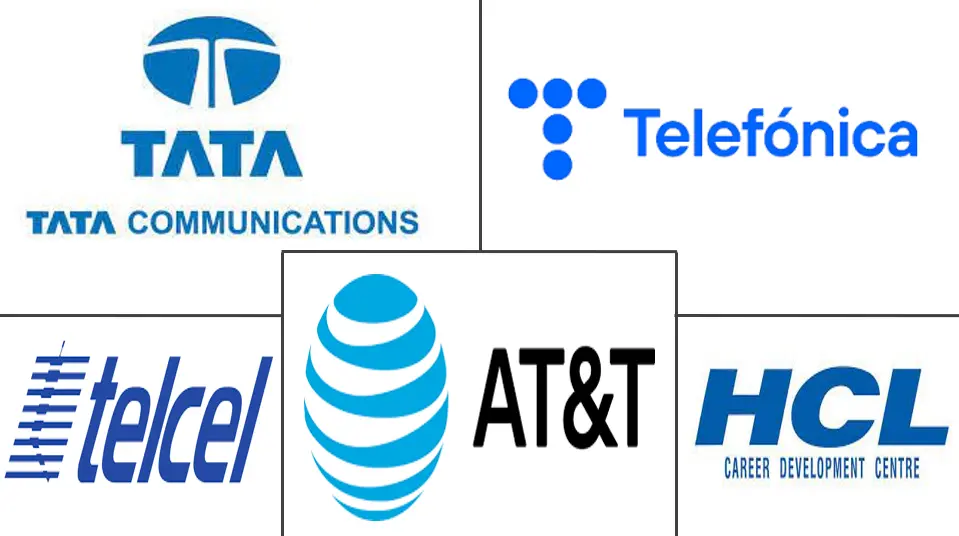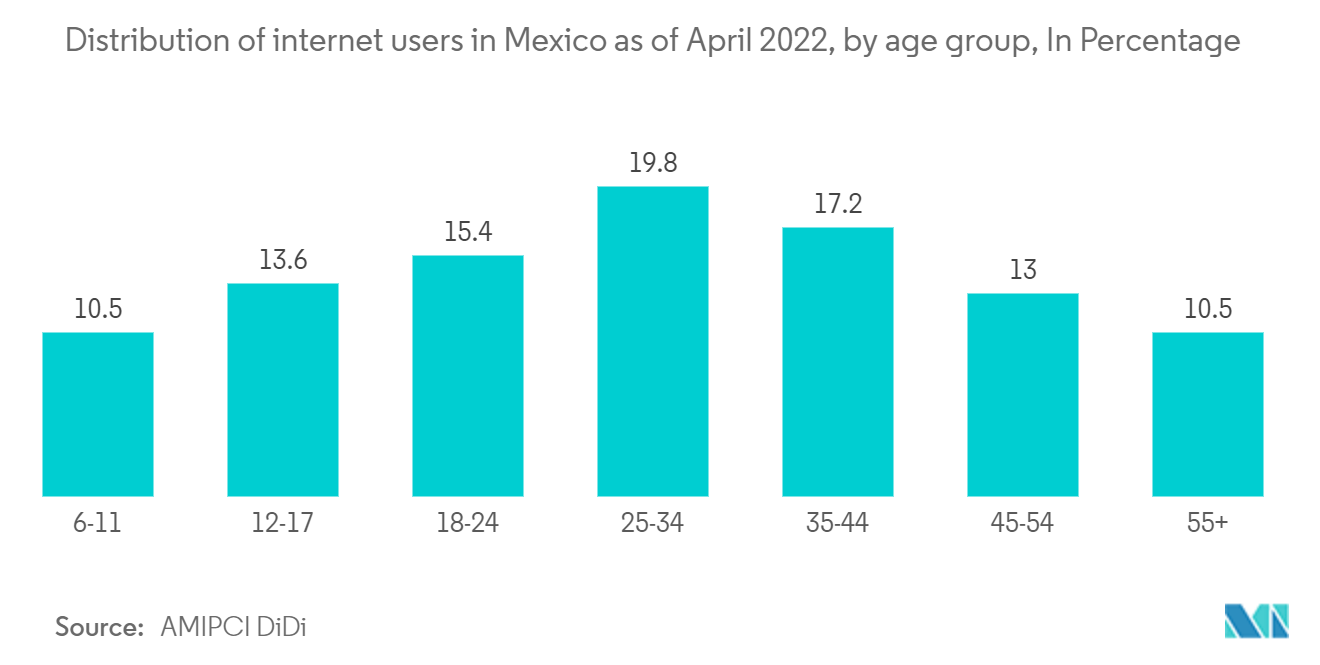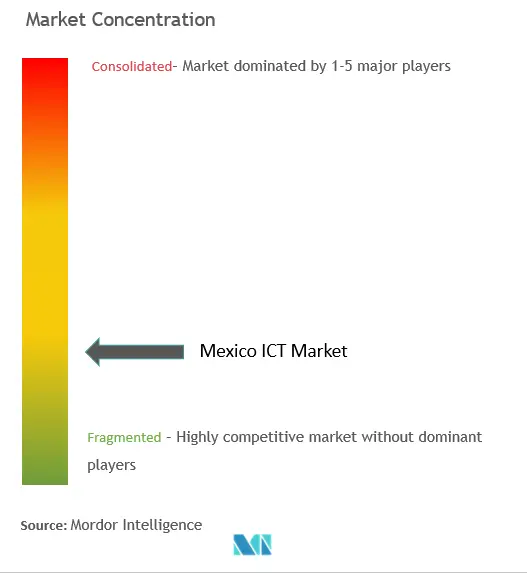Mexico ICT Market Size

| Study Period | 2019 - 2029 |
| Base Year For Estimation | 2023 |
| Forecast Data Period | 2024 - 2029 |
| Historical Data Period | 2019 - 2022 |
| CAGR | 10.60 % |
| Market Concentration | Medium |
Major Players
*Disclaimer: Major Players sorted in no particular order |
Mexico ICT Market Analysis
The Mexico ICT market is anticipated to record a CAGR of 10.6% over the forecast period. The increased focus on digital technology, cyber security, AI, robots, and healthcare IT drives the market.
- The ICT sector and digital economy are the economic drives that significantly contribute to Mexico's GDP. Mexico's digital economy creates roughly USD 60 billion in economic value yearly through business process management (IT-BPM), e-commerce, domestic electronics manufacturing, digital payments, digital communication services (including telecom), and other ICT-related activities.
- Mobile broadband can cover a vast nation like Mexico, enabling the administration to provide all its residents with services like e-health and e-education. Broadband, in general, boosts productivity while encouraging innovation in Small and Medium-Sized Enterprises (SMEs) and delivers considerable savings by lowering transaction costs. The broadband investment significantly impacts Mexico because it could unlock excellent development prospects.
- In February last year, Mexico witnessed the launch of the first commercial 5G mobile network. The deployment presents a significant opportunity for the nation's development and digitalization. The GSMA predicts that the rollout of 5G would have a considerable economic impact on Latin America, with an expected 5% GDP growth and a USD 90 billion rise by 2034.
- Even though digital innovation is sometimes acclaimed as the way to speed up socio-economic development worldwide, the digital gap is still quite wide in places like Mexico, where fewer than half of the population has access to the internet. Although the Mexican government has made enormous efforts to upgrade its digital infrastructure, more than half of the population still needs to be connected to the internet.
- While COVID-19 increased Mexico's digitization and altered its purchasing patterns, Mexican e-commerce grew by 27% in 2021 over the prior year, according to data from the Mexican Association of Online Sales (Asociación Mexicana de Venta Online, or AMVO). Mexico has been among the top five nations in the world for the past three years in terms of e-commerce growth. The Covid-19 pandemic has highlighted the significance of a digital world where more individuals may benefit from technology. Considering the Covid-19 pandemic, technological advancement is more crucial than ever and necessitates quick and durable digital development models.
Mexico ICT Market Trends
This section covers the major market trends shaping the Mexico ICT Market according to our research experts:
Significant Growth in Telecommunications Sector
- Mexico is the second-largest market after Brazil, accounting for approximately USD 81 billion in the region's telecommunications industry. Mobile services are often far more widely used than fixed-line services. For instance, in Mexico, there are 93 mobile cellular subscriptions for every 100 residents as opposed to only 18 for every 100 residents with landline phone service. Despite this, both fixed-line and mobile companies claim reasonable subscriber growth rates.
- Nevertheless, residents in the nation don't frequently rely on fixed-line services alone; more than 50% of Mexican households exclusively have mobile service plans, while just 36% have fixed-line and mobile service contracts. The Mexican telecommunications sector has regularly outperformed GDP growth over the past ten years, primarily due to the rise of mobile, broadband, and broadcasting. The widespread use of cell phones dramatically facilitates mobile internet usage. More than 132 million cell phones were used nationwide in the previous year.
- Telcel is the most valuable Mexican telecom brand and a revenue engine. The revenues of Telcel, the second-placed firm, as a fixed-line phone service and broadband internet provider, are approximately four times larger than AT&T's. Joining Telcel and AT&T is Telefonica, which conducts business as Movistar in Mexico. With a market share of more than approximately 60%, Telcel continues to be the industry leader in the mobile space.
- Early last year, there were almost 450 million unique mobile users in Latin America. By 2025, there will be 485 million, or 73% of the population, predicts the GSMA's assessment of the region's mobile economy for 2021. Significant participation from Mexico is anticipated in this expansion. From 65% in 2020 to 70% in 2025, mobile subscriber penetration is expected to increase across Mexico. From 57% in 2020 to 66% in 2025, the country's mobile internet use is expected to soar. After Brazil, Mexico is predicted to have Latin America's second-best smartphone market.
- AT&T was the first telecommunications provider to declare the launch of 5G in Mexico in 2021. AT&T stated in July last year that they anticipated having 5G connectivity in 25 Mexican cities by year's end. Mexico City, Guadalajara, and Monterrey are said to have the most excellent 5G connectivity thus far. However, beginning in the summer of the last year, AT&T customers in Morelia, Saltillo, Obregón, Hermosillo, and Culicán may count on 5G connectivity.

Rising Digital Adoption in Mexico
- The trend in the adoption of digitalization technology is rising in Mexico. The country's state governments are only starting to use modern technology. Emerging technologies like cloud computing, big data, the Internet of Things (IoT), and artificial intelligence are starting to be used by governments. Mexico has tried adjusting to the quick changes in its society. The nation is working to create an environment that would encourage tech-driven innovation.
- COVID-19 has greatly influenced Mexico's aim to become a completely sustainable nation by 2020. The nation's businesses of all sizes prepared better than the rest of the globe to begin the nation's digital transformation project. The globe used 39% of the internet's resources at the beginning of this year, while Mexico had 52%.
- One of the pillars of contemporary technology has been AI. It's associated with the word "smart" when discussing technology like smartphones, smart automobiles, and smart toilets. Several firms in Mexico that produce electrical devices are presently applying AI algorithms to develop cutting-edge smart items that are easy to use. Additionally, software development businesses are integrating AI into their computers to assist decrease failure rates, speed up development, and offer precise cost and timeframe predictions for the software and strategic management.
- It is anticipated that Mexican IT firms would use AI and IoT infrastructure last year without possessing the rights to any proprietary cognitive programming or servers. It would assist in lowering coding expenses and accelerating the software development procedures. Adopt this revolutionary concept of no-code interfaces into your business. A lack of programming expertise or a lack of understanding of data structures will no longer be a barrier.
- Escalated internet connection has supported the digital sector's fast growth in Mexico. According to the Mexican Internet Association, 89.5 million individuals, or 75.7% of the country's population over the age of six, were online by the early last year. Only 48% of individuals in rural regions have access to the internet, and internet users are disproportionately concentrated in metropolitan areas.
- Nearly a quarter of Mexican internet users in April last year were in the 25-34 age bracket. Mexicans between the ages of six and eleven made up around 10.5% of online users, which is the same percentage as people over 55. In the meanwhile, the majority of internet users in the nation were women.

Mexico ICT Industry Overview
The Mexico ICT market is moderately competitive and moving towards the fragmented stage as the market currently consists of many players. Several key players in the ICT market are in constant efforts to bring advancements. A few prominent companies are entering into collaborations and expanding their footprints in developing regions to consolidate their positions in the market. The major players in the country include Nokia Communications, HCL Technologies, Oracle Limited, and many others.
- In July 2022, Nokia confirmed a partnership with AT&T Mexico as they look to accelerate 5G in the country. This partnership would also support the development of a 5G lab aimed at growing Mexico's 5G ecosystem.
- In September 2022, Oracle and Telephones of Mexico partnered to offer Oracle Cloud Infrastructure services in Mexico. The strategic alliance would enable organizations to take advantage of the enterprise-grade performance, security, and powerful multi-cloud and data analytics capabilities of Oracle Cloud Infrastructure.
Mexico ICT Market Leaders
-
AT&T Mexico
-
Telcel
-
Tata Communications
-
Telefonica Mexico
-
HCL Technologies Mexico
*Disclaimer: Major Players sorted in no particular order

Mexico ICT Market News
- In October 2022, Oracle and NVIDIA collaborated to accelerate Enterprise AI Adoption in Mexico. To better serve clients and increase revenue, the two businesses want to drive innovation across several industries made possible by artificial intelligence.
- In September 2022, AT&T launched 5G in Mexico City. Tijuana, Mexicali, Ciudad Juárez, Mazatlán, Ciudad Obregón, Navojoa, Guasave, Ensenada, Puerto Pasco, and Guamchil are now covered by AT&T's nationwide 5G network deployment. Meanwhile, coverage in Mexico City, Guadalajara, and Monterrey is still growing.
Mexico ICT Market Report - Table of Contents
1. INTRODUCTION
- 1.1 Study Assumptions and Market Definition
- 1.2 Study Assumptions
- 1.3 Scope of the Study
2. RESEARCH METHODOLOGY
3. EXECUTIVE SUMMARY
4. MARKET DYNAMICS
- 4.1 Market Overview
-
4.2 Market Drivers
- 4.2.1 Robust Demand for Telecommunications Services
- 4.2.2 Integration of Emerging Technologies like IoT, Cloud &AI in the Business
-
4.3 Market Restraints
- 4.3.1 Persistent Digital Gap in the Rural Population
- 4.4 Impact of COVID-19 on the IT Spending
5. KEY TECHNOLOGY INVESTMENTS
- 5.1 Cloud Technology
- 5.2 Artificial Intelligence
- 5.3 Cyber Security
- 5.4 Digital Services
-
5.5 Porter's Five Forces Analysis
- 5.5.1 Threat of New Entrants
- 5.5.2 Bargaining Power of Buyers/Consumers
- 5.5.3 Bargaining Power of Suppliers
- 5.5.4 Threat of Substitute Products
- 5.5.5 Intensity of Competitive Rivalry
- 5.6 PESTLE Analysis
- 5.7 Assessment of COVID-19 Impact on the Industry
6. MARKET SEGMENTATION
-
6.1 By Type
- 6.1.1 Hardware
- 6.1.2 Software
- 6.1.3 IT Services
- 6.1.4 Telecommunication Services
-
6.2 By Size of Enterprise
- 6.2.1 Small and Medium Enterprises
- 6.2.2 Large Enterprises
-
6.3 By Industry Vertical
- 6.3.1 BFSI
- 6.3.2 Telecom and IT
- 6.3.3 Government
- 6.3.4 Retail and E-commerce
- 6.3.5 Manufacturing
- 6.3.6 Energy and Utilities
- 6.3.7 Other End Users
7. COMPETITIVE LANDSCAPE
-
7.1 Company Profiles
- 7.1.1 Tata Communications
- 7.1.2 HCL Technologies
- 7.1.3 Infosys Ltd
- 7.1.4 Tech Mahindra Ltd
- 7.1.5 Wipro
- 7.1.6 Mphasis
- 7.1.7 Capgemini
- 7.1.8 AT&T
- 7.1.9 Intel Security (Intel Corporation)
- 7.1.10 Telefonica Mexico
- 7.1.11 America Movil
- 7.1.12 Telcel
- 7.1.13 Telmex
- 7.1.14 Telesites
- 7.1.15 Logitel
- *List Not Exhaustive
8. MARKET OPPORTUNITIES AND FUTURE TRENDS
** Subject To AvailablityMexico ICT Industry Segmentation
Information and Communication Technologies or ICT is a broader term for Information Technology (IT). It refers to all communication technologies, such as wireless networks, the internet, computers, cell phones, software, videoconferencing, middleware, social networking, and other media applications and services enabling users to store, access, transmit, retrieve, and manipulate information in a digital form.
The Mexico ICT market is segmented by type (hardware, software, IT services, and telecommunication services), by the size of the enterprise (small and medium enterprise and large enterprises), by industry vertical (BFSI, IT and telecom, government, retail and e-commerce, manufacturing, and energy and utilities). The market sizes and forecasts are provided in terms of value (USD million) for all the above segments.
| By Type | Hardware |
| Software | |
| IT Services | |
| Telecommunication Services | |
| By Size of Enterprise | Small and Medium Enterprises |
| Large Enterprises | |
| By Industry Vertical | BFSI |
| Telecom and IT | |
| Government | |
| Retail and E-commerce | |
| Manufacturing | |
| Energy and Utilities | |
| Other End Users |
Mexico ICT Market Research FAQs
What is the current Mexico ICT Market size?
The Mexico ICT Market is projected to register a CAGR of 10.60% during the forecast period (2024-2029)
Who are the key players in Mexico ICT Market?
AT&T Mexico, Telcel, Tata Communications, Telefonica Mexico and HCL Technologies Mexico are the major companies operating in the Mexico ICT Market.
What years does this Mexico ICT Market cover?
The report covers the Mexico ICT Market historical market size for years: 2019, 2020, 2021, 2022 and 2023. The report also forecasts the Mexico ICT Market size for years: 2024, 2025, 2026, 2027, 2028 and 2029.
Mexico ICT Industry Report
Statistics for the 2024 Mexico ICT market share, size and revenue growth rate, created by Mordor Intelligence™ Industry Reports. Mexico ICT analysis includes a market forecast outlook to 2029 and historical overview. Get a sample of this industry analysis as a free report PDF download.



